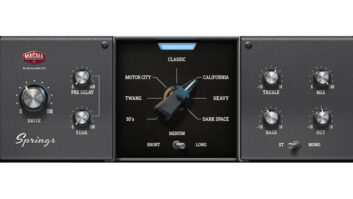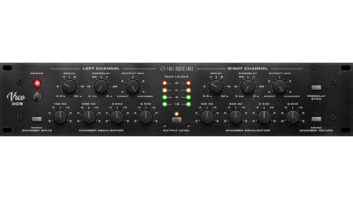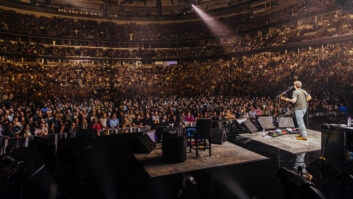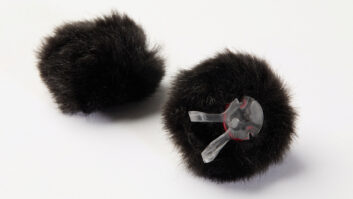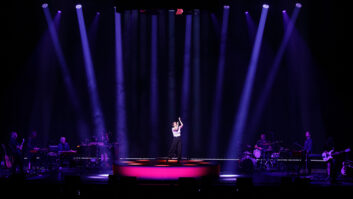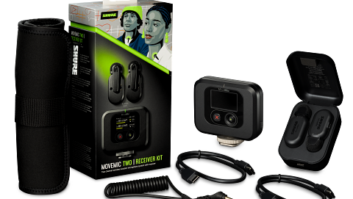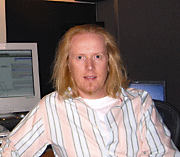

Ch-ching! The bean-counters will doubtless be happy with the box-office returns from the third installments of these four franchises: Spider-Man 3, Ocean’s Thirteen, Shrek the Third and Pirates of the Caribbean: At World’s End. But we’re here to talk about audio.
FRESH SOUNDS FOR SPIDER-MAN 3
The last time we checked in with supervising sound editor and sound designer Paul Ottosson three years ago, he was finishing up work on Spider-Man 2 (July 2004), for which he would receive an Oscar nomination. When we speak again in April 2007, Ottosson reveals that he’s worked on and off for the past two years on Spider-Man 3, which, it turns out, was even more taxing than the previous one — ain’t that always the case!
Spider-Man 3’s sound designer/editor Paul Ottosson in his studio
With most of the same team coming back (director Sam Raimi, editor Bob Murawski and much of the sound crew — production mixer Joesph Geisinger, supervising ADR and dialog editor Susan Dudeck, re-recording mixers Gregg Russell and Kevin O’Connell, et al), the machine was in place for a smooth entry into the complex new world of Spider-Man 3, which in addition to introducing us to the evil villains Sandman and Hobgoblin, also features Spidey’s evil alter-ego, dark Spider-Man, who morphs into Venom. For Ottosson, the work on 3 began before the script was even in place.
“Sam storyboards the whole movie,” he says. “Then, with certain scenes, he wanted to see how they would play, so I cut some sound effects for Spider-Man 3 way before they were done writing it. We’d look at it with the producers and go back and forth about what we might need. There are a couple of moments that are identical [to the original concept]. We kept going for more sounds, hopefully bigger and better sounds with more detail, but the idea of how things worked is very close to what we worked on two years ago.”
Ottosson says that he and Raimi and Murawski talked extensively about the complexities of the Spidey-Venom relationship and how it could be reflected sonically. “With regular Spider-Man, he’s almost like a ballet dancer in the air, so you want it to sound somewhat delicate,” Ottosson says. “You can hear a lot of small subtle movements of the feet and the hands. Venom is more of a brute — when he punches, and his web is a different kind of web — it’s almost like gnarled barb wire versus Spider-Man, whose web is silky and smooth. When Venom’s web fires and it’s covering over the city, we wanted to get across a certain tonal quality, like hitting piano strings on the inside. We strung some ropes across stages here and sort of played them like a huge cello of some kind; very strange. It was a lot of work. The web itself when it fires is a bunch of different recordings — creaks, little animals snuck in there, rope to give it a gnarled, leathery, creaky sound. It’s got to be an evil, dirty sound compared to Spider-Man.
“The web is almost alive with this goo that becomes the suit for black Spidey and Venom, and there are other layers of sound in that, like flank steaks and meats I would semi-freeze, and then cut them with a knife and kind of tore them off to get a tearing sound. We also recorded some meat stuff with the Foley guys; they gave me a batch of sounds — they had turkeys, ribs and chickens on this huge cart. There’s also some liquid-y wetness in there, too. Even though what’s happening is the goo attaching itself, I wondered, ‘What if it were more like he was being ripped apart instead? So it’s almost the opposite of what you see on the screen. It think it’s pretty effective.”
Ottosson’s main recording rig is a Sound Devices 722, which he likes for its portablity, stock battery, clean sound, menu structure and acceptance of an SAS FireWire hard disk, which gives him plenty of space even when recording at 24-bit/192kHz. After tagging the files, they get loaded into Pro Tools.
For this film, one of Ottosson’s greatest challenges was coming up with sounds for the ever-changing Sandman character. Actual sand, it turns out, is a tough medium to record.
“The sound of sand falling or moving is almost like white noise — sssshhhhhh — and that’s something you usually try not to get in your recordings,” Ottosson says. “So part of what we used was the sound of big rocks breaking and hitting. If you just hit two rocks together, that’s a pretty thin sound; in fact, it’s almost like metal in that way. It’s not a sound you want to listen to too many times. I knew that east of L.A., out by Palm Springs, they have a different kind of rock — it’s like a sandstone. If you smash two together, you can get them to break and you’ll get a thicker sound. So way early on, even before the movie got started, I went with my wife and we bought a bunch of different sledgehammers and pick-axes. I’d take these rocks, as heavy as I could carry, and drop them down 10 or 15 feet, and they’d break and shatter and some would almost explode. I’d record that and I’d also get the resonating part from the ground itself. I’d use one dynamic mic and one condenser mic up close; two monos. So I used some of those sounds for movement for Sandman when he’s walking. I did a little bit of EQ’ing and compression with these McDSP plug-ins — I compressed the heck out of the low end.
“You also have sand sheathing off every time Sandman moves,” Ottosson coninues. “We needed something to represent what you see on the screen. So I bought these huge restaurant-sized bags of salt and sugar, Rice Krispies, coarse salt, beans, herbs — different things like that. I recorded something like 20 different foods to get the sheathing sound. Depending on what was happening onscreen, I would pour some onto a flat concrete surface, but also I might pour sugar on top of the rice. Some I would pour through a pipe so I’d get some ‘whoosh’ movement through the pipe. I would also sometimes move the mic toward the source and by it as I poured it, and I would get a weird sort of Doppler effect.
“The other thing we had to deal with is that Sandman is a regular-sized guy in the beginning, made out of compact sand, and he’s got to sound different from when he’s the giant sandman later, so there’s this progression in the sounds. In the end, he needs to be as big as he can.”
Working on a film that’s full of big, loud action scenes, Ottosson and the rest of the sound team were kept extremely busy for months on end, and as is usually the case with heavy-CGI films, were still fine-tuning and filling in holes up to the very last second as final FX came in and the mix was in full-swing at Sony. (For more on specific scenes, see mixonline.com). “This isn’t like a war movie or a car chase movie,” Ottosson says. “A movie like this has everything; all this incredible action. You have [Hobgoblin’s] sky stick flying around and they’re fighting on that; different swords that have laser electricity; fighting with ‘razor bats,’ these bombs that have their own life and personality. There’s fighting over subways, with trains going back and forth; car chases; just so much. I do love it, but when it’s over you feel punished. My first thought when I walked off the lot was, ‘I never want to do another one like this.’ It absorbs everything in my life. It’s been six to seven days a week for 10 months.”
Okay, but how about those rumors that there might be a fourth Spider-Man film up the road? “Oh, I’d love to do it, of course!” he says with a laugh.

WATCH: More Film Pics
READ: More Quotes
Paul Ledford, production sound mixer for Oceans Thirteen, on delivering tracks to the transfer house, in this case Technicolor Sound Services:
“We do a sync test before every picture and that serves as a sort of Rosetta Stone that passes through all of the different stages or pieces of equipment or, nowadays, different software versions, so when we step into productions we don’t have surprises in dailies or further on in the editorial processes.
“I’ll also send a daily e-mail brief to the transfer folks. I’ll tell them how each scene is done and if there was anything notable they should know about on their level. Sometimes in the middle of the night they have to do some detective work if the notations aren’t clear enough. Then, to take that one step further, I started writing down things like, ‘For this isolated track here we bounced between the lavs and then went back to the boom’; Things that might also be of use to the post sound editors.
“I’m marrying all the tracks to a DVD-RAM. That goes into transfer and transfer picks off tracks 1 and 2, which goes to dailies. Then the DVD ram goes to the picture editorial people and they can go back and find any tracks they wish. Otherwise the DVD-RAM will pass on to post sound. But at the end of the picture we also do a full backup from the Deva to a FAT32 hard drive so all the sound resides on one drive.”
On working with the same actors over a several different years:
“It took a little while to get the mics right, even having done the previous two, because it’s been two years and people’s voices change a little bit. I know where George [Clooney] is going to be [sonically], where Brad [Pitt] is going to be, but so-and-so sounds like this now, or their wardrobe might be a little different from show to show, so I might choose a different lavalier; whether I’d use the [Countryman] B6 or the Sanken [COS 11]. And of course we had new people in it. In this case we had Al Pacino and Ellen Barkin, so it takes a little while to figure our which mikes sound best with them.
On the fast-paced challenge of working on Traffic:
“Those were 2-tracks, very much reality, mixing by the seat of your pants, watching what cameras are doing, flying wireless mics in as things evolved. Portions of the film were standard, but some of the material on the streets was very much in guerrilla mode. It could be pretty tiring, but it was also exciting and a lot of fun.”
On doing production sound for low- budget indies:
“I did Slingblade and I’ve done a few others. The budget might affect the number of takes a director does, so you really have to get the performance when it happens. But whether it’s a large budget or a small budget, you still have to have microphones in the right places so people understand what they’re saying, and, of course, you have to watch the recording. Steven [Soderbergh] is always pushing us all to be more clever; to come up with ideas on set that will translate and help in post-production to give him more choices.”
Paul Ottsosson, sound designer on Spider-Man 3, on the Sandman character:
“After we cut say 100 feet of it I bring Sam [Raimi, director] over and say, ‘Here’s what I had in mind, what do you think?’ In the case of Sandman he liked it right away. I cut some of the end sequences where he’s like 80 feet tall and showed it to Sam. What I usually do is crash it down to a stereo track and then give it to the picture editors and they live with it in the Avid for the remainder of when they’re working on the movie.
“One challenge on Sandman was his roaring, which had to be reflective of how big he gets. I always try to get [actor] Thomas Haden-Church to do his voices because he’s really full-voiced by himself. I thought that would better than just using a bunch of bears or lions or whatever. This way you can get the inflection of his human voice going through the pain, or challenging Spider-Man. So I had three or four ADR sessions with him to do Sandman roars and efforts and reactions to certain things. I pitched him down a tad and compressed it and EQ’d it. You can still hear that it’s him, which I really like. I think there’s only one spot where we sweetened it with and animal.”
On creating sounds for Hobgoblin’s “skystick”:
“The skystick is almost like a snowboard with a lot of weapons. That involved a lot of recording. I knew about these miniature jets I’d seen on the Internet, so I thought it would be interesting to get the sound of these small jet engines. So I strapped some wireless mics on these miniature, six-foot, jets. They function like real jet planes and was a lot easier to walk around that with a mic than getting a real F-16. I could get two inches away from the engine, which was great for picking up these high, squealing whines. Then we also followed with a shotgun mic, or we moved the microphone and left the jet stationary. Sometimes the jets would crash and burn and the engines would die. I have so many recordings, someone shouting “F___!” and the jet goes down!” [Laughs]
And that weird noise of the “razor bats”:
“My wife plays this [Chinese] stringed instrument called the erhu; she’s a virtuoso. It’s a very sensual kind of instrument. It doesn’t have a fret board, so it’s all feeling; there’s a lot of expression. Anyway, on Grudge 2 there were scenes where people had been possessedtaken over by the eviland so I took the sound of my wife playing the erhu and screwed around with it and made it sound evil. I remember liking the qualities in the instrument, the variance when she played it. So for the ‘razor bats,’ which are bombs with blades on the side used by Hobgoblin] a lot of the sound of that comes from her playing.”
To hear an erhu demonstration and to see a cute wedding photo of Pail Ottosson and Karen Han, go to karenhan.com.
DEMANDING DIALOG FOR OCEAN’S THIRTEEN
Though director Steven Soderbergh’s three Ocean’s films are visually arresting (he is the director of photography, too; Stephen Mirrione edited them), they are driven more by dialog than by action. The intricacies of the story are usually revealed through often-subtle character interactions instead of by big visual payoffs, so getting crisp, clear production recordings is essential.

Ocean’s Thirteen crew, from left: mixer Paul Ledford; David Katz, video assist; Ross Levy, utility sound; and boom operator Randy Johnson.
Paul Ledford has been the production sound mixer for nearly all of Soderbergh’s films, all the way back to the director’s breakthrough, sex, lies, and videotape. In fact, Ledford and Soderbergh go back even further — Ledford was a student at LSU when he befriended the 14-year-old Soderbergh. “We got to go down the road together with our passions,” Ledford says during a break from scouting locations for Bertrand Tavernier’s upcoming film, In the Electric Mist. “I got lucky that Stephen that he was able to bring a few of us along as crew.” (Supervising sound editor/re-recording mixer Larry Blake has also been a fixture of Soderbergh’s productions and worked on all three Ocean’s.)
Because the Ocean’s films are ensemble pieces that often have many important speaking roles within a scene, capturing the production dialog can be a complicated affair requiring multiple radio mics in addition to deft overhead work by Ledford’s regular boom operator, Randy Johnson. “Any time we had all of them there, all of them talking, those were big challenges,” Ledford notes. “There are so many people to deal with, to get all the [track] assignments and everything hooked up and ready to go isn’t easy. And Steven’s often happy to shoot available light, so you really have to be nimble and ready to go. Waiting on power is not something he’s into. So I run all my cart on DC power.”
Ledford has used a different recorder for each of the Ocean’s films: “Eleven was DAT through an Apogee A/D going 20-bit and then down to DAT [16-bit]. Ocean’s Twelve was a [Zaxcom] Deva II [4-track hard drive, 24-bit] and now we’ve got the Deva V [10-track]. For this show, we used Lectrosonics 400 Series [RFs], with mostly Sanken COS-11 lavaliers, along with the Countryman B6, which has a low impact on wardrobe because it’s such a small microphone. The Sankens match the Schoeps overheads very well.” He uses a Cooper 208D mixer after many years of relying on a Cooper 106.
“I do the A-to-D conversion in the Cooper and feed that AES to the Deva, and then we feed the isolated tracks analog,” he says. “We did a test and we didn’t find any timing issues. The great benefit of working with Larry [Blake] all these years is together we’ve stepped through a lot of issues that you might not deal with on other films because you don’t have access to the post sound people so early on. He’s taught me a lot about doing the homework ahead of time.”
Still, Soderbergh can continue to surprise his colleagues. For Thirteen, he wanted to keep backgrounds going and alive on the sets, primarily to motivate the action through playback. “In one scene, we were running sound effects of helicopters, which weren’t actually running — they were on a crane and gimbel,” Ledford explains. “Ordinarily, you would say, ‘We’ll run the sound effect up to the dialog,’ but Steven said, ‘No, I want to run everything together and you’ll get the dialog.’ I thought, ‘Really? Okay, fine, let’s see what happens.’ That’s a place where using well-placed lavaliers is crucial. There were also scenes doing dialog with the 500-plus extras going at it in the casino and sound effects going through massive speakers.
“There were slot machines brought onto the set that were built for Thirteen, and while they were installing them we’d turn the normal noises off. But the people in the casino and the dice and the card-playing and the chips and all that play in the background and all make noise. Larry tells me that on Thirteen there’s only a handful of lines that were changed or added for story purposes, but the production dialog is pretty much intact.”
KEEPING IT REAL (SORT OF) FOR SHREK THE THIRD
When I reach Shrek the Third co-supervising sound editors Thomas Jones and Richard Anderson on the Howard Hawks soundstage at Fox, they’re working on an M&E mix of Shrek the Third, “making it safe for foreign people,” Anderson quips. “I’ve noticed that with foreign versions of animated films I’ve worked on, including languages that are totally different than ours, like Chinese, how well it syncs. It’s probably because there’s exaggerated movements of the mouth.”
No question about it, working on animated features brings its own demands and challenges, but these two guys are masters of the genre. Together they’ve worked on such animated films as Flushed Away, Over the Hedge, Madagascar and Shark Tale, and Anderson’s earlier resume includes Antz, The Lion King, The Nightmare Before Christmas, Anastasia and others. “Actually, we started out doing live-action films together,” Jones says. “I’d take care of the dialog and he’d take care of the effects, and eventually it carried over into the animated realm.
“Working with dialog in animation is a little different because when I record the group vocals, it’s treated more as an effect than as real dialog — as opposed to a live-action movie where you’re seeing people and you’re filling them in and blending in ADR with production dialog. In terms of the dialog, and this carries over into the effects, because it’s so clean and we have nothing we have to match into, you get to focus more on creating the emotion of the scene rather than trying to step around what already exists, like a live-action production track.”
This is the first Shrek film the duo has worked on, and from the outset they learned from producer Aaron Warner that there were a few ground rules for the sound. “Their approach is, as much as possible, to play the sound realistically,” Anderson says. “They don’t go for the traditional exaggerated comedy sounds. They play it like a live-action film more often than not. Of course, there are exceptions to that. They’ll sneak in a cartoon-y effect here and there — like Pinocchio’s nose growing.
“In films like Over the Hedge and Flushed Away, you had this sound scale where you’re dealing with the world as experienced by small creatures where normal human objects appear huge, so they had to sound big yet what the normal object would sound like. In this movie, even though it’s a fantasy world, it looks very realistic, other than being a world with dragons and talking cats and the rest of it. There’s also a wizard in there and that was a lot of fun because what does magic sound like?”
Although there were some carryovers in FX from previous Shrek films, including some of the dragon vocalizations and Pinocchio’s nose, there was still plenty of new work to be done by Anderson and his FX team, such as various medieval mechanical machines “that were supposed to be fun and rickety but at the same time they had to be big enough that you believe them,” he says. “So we went through the library and found a bunch of wooden ratchety things and gears and squeaks and put them together in interesting ways.
“Tom and I both work for Technicolor Sound Services right now and we have quite a library at our disposal. And it became bigger when we became part of Technicolor. I had my own company, Weddington, and we had a library there that we’d had for years, and that got incorporated into the Technicolor library, so it’s huge. Still, we love to record stuff. No matter how big your library is, there’s always something you don’t have.
Jones got into the FX game designing sounds for the “dronkeys” — the half-donkey, half-dragon offspring of Eddie Murphy’s donkey character and the dragon who hooked up in Shrek 2. “What the hell does a donkey-dragon baby sound like?” Jones asks with a chuckle. “I used lion cubs, various birds, camel; we had some turkey in there.” Anderson: “That didn’t make it into the final.” Jones: “They needed to sound like they’re trying to communicate as opposed to just making noises. And they had to be cute.”
Meanwhile, on the dialog end, Jones had to deal with a perennial issue of animated films — dialog parts that are recorded years apart in different places. “They probably did the original recordings for this three years ago, and they’ve added things until very recently.” Anderson elaborates, “Or, as likely, they get a new idea, a new line, a new joke or whatever, they go back and get the actor, but now he’s on location in Mongolia shooting a movie, so they have to find a studio there and they record him there, and maybe he has a bit of a cold that day, so you have all these pieces of dialog that were often recorded years apart and now at the final you’re trying to mix it so it sounds like a coherent thing. Every animated film I’ve ever worked on has this problem.”
The film was mixed at Fox by the team of Anna Behlmer and Andy Nelson, who worked on the first two Shrek films, as well, “so we knew whatever we did we’d be in good hands,” Anderson says. “They always do good work.”
ON THE HIGH SEAS WITH PIRATES 3
Like its immensely successful progenitors, Pirates of the Caribbean: At World’s End is the quintessential “popcorn” movie — big and loud, full of incredible action sequences and exotic sets. But these are far from pedestrian entertainments. They have been hits in part because they are so well-crafted from top to bottom, including the sound. Indeed, the first two installments of the series each earned Oscar nominations for Best Sound Editing (Christopher Boyes and George Watters II) and Best Sound Mixing (Boyes, Lee Orloff, David Parker and David Campbell on P1; Paul Massey on P2). And no doubt P3 will also be hailed for its imaginative audio.

Christopher Boyles, Skywalker Sound sound designer/re-recording mixer worked on Pirates 3.
Much of the same team is in place, including co-supervising sound editors Watters and Boyes (who’s also lead sound designer and a re-recording mixer) and mixer Massey, all working under the inspired direction of Gore Verbinski, who certainly isn’t afraid to think big and encourage everyone he works with to be as creative as they can be.
Boyes manages to fit in a short interview during a much-needed break in the final mix at the Henry Ford dub stage at Fox in April. The final for a film this big is usually brutal, I remark. “Well, it’s definitely long hours,” Boyes replies, “but I wouldn’t attach ‘brutal’ to it. It’s going really well. Everybody’s really happy and, most importantly, Gore, the director, is really happy. We have enough time on this mix to do some experimentation, which is not always the case, and really dial it in to exactly where he wants it to be. Things like whether we want to make a scene really spare and let the music carry it, or let the dialog carry it, or how much we want to complicate it.
“If we’re in the brig of the Flying Dutchman, how much do we let the groaning and creaking and drone of the ship itself be a character, and how much do we pull that back so you can lean into the dialog? It’s that give and take that is so key to a track. We’re diving in and out, not just of different environments, but within the same environment hitting different emotional places, which is a lot of fun and a wise way to use sound.”
The Pirates stories have become increasingly complex, with P3 the most intense of the lot. Not only does it feature various completely different competing war ships, squid-faced Davy Jones and his motley crustacean-oid crew (one of the big sound challenges of P2 — Boyes and his assistant Dee Selby did a lot of fish and crab squishing and smashing at Fantasy Studios’ Foley pit), and sea battles aplenty, but there is the promise of the title: world’s end.
“It’s not quite literal,” Boyes teases, “but you know there is a massive waterfall and you have to make the assumption that someone is going over that waterfall, and that really required a lot [from the sound team]. It’s a massive amount of water, which we have to convey the power and majesty of, at the same time as sitting [the FX] with a choir and Hans Zimmer’s score. The sound comes from a number of components — heavy rushing water mixed with some ice movement and things of that nature. It’s really the intent of the track there to play the mass and power without having to be really loud, and it’s quite effective in that way.
“Sailing is a big part of this film,” he continues, “and the climax takes place in very rough waters, with boats doing very intense things and cannon shots flying all over the place, so that’s a lot of fun. Dee Selby and I went back to Ohio and recorded new cannons and muskets outside of Toledo with a Civil War re-enactment group. They shot these cannons into a massive quarry that must go 200 feet down and be the size of several football fields. So we were able to get all kinds of wild echoes as these cannons blasted in and out of there. We took everything we had in our war chest on that trip, including 11 mics, two 2-track Sound Devices [recorders], a 4-track and a DAT.
“Dee and I also got on a Tall Ship and sailed down from Oregon to the Golden Gate Bridge, and we did a lot of recording because this film tales place on various vessels — each with its own characteristics. We really wanted to sell, ‘Are we on the Endeavor or the Black Pearl or the Dutchman or The Empress, this Chinese junk where Chow Yun-Fat has his lair?’ There’s an intimate scene in his captain’s quarters that was really fun to work on: We’ve got Asian/Tibetan chimes and bowls playing in the ambient track, as well as these very emotional creaks and groans that are really intended to weave in and out of emotional moments within the dialog and the music. I recorded those creaks in a little triangular room at the very bow of the ship as it was plowing through waves, and there were all sorts of big paint cans and other things rubbing up against this wood, and the sound of the water rushing against the hull. I ended up playing with those sounds and coming up with these descending and ascending groans.”
Of course that barely scratches the surface of this huge FX job. Besides a frozen sea and Davy Jones’ locker, listen for some of the little touches — like the “nine pieces-of-eight,” each with its own signature tonality, devised by Boyes. Yaarrr!
Blair Jackson is
Mix‘s senior editor.

